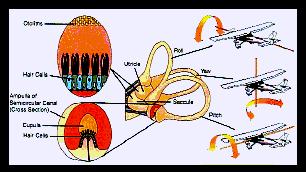Aviation Physiology
Spatial Disorientation: Spatial disorientation occurs when there is a conflict between the signals relayed by your central vision and information provided by your peripheral vision. Spatial disorientation is more likely when a pilot is in IFR conditions.Anyone who has ever parked your car along side another and stopped just as the opposing vehicle was beginning to move backwards has experienced this illusion of motion. You have a false sense that your car is moving caused by your view using peripheral vision.
Vestibular Disorientation: The vestibular system located in your inner ear consists of the vestibule and three semicircular canals. The utricle and saccule organs within the vestibule are responsible for the  perception of gravity and linear acceleration. A gelatinous substance within the utricle and saccule is coated with a layer of tiny grains of limestone called otoliths. Movement of the vestibule causes the otoliths to shift, which in turn causes hair cells to send out nerve impulses to the brain for interpretation.The semicircular canals are oriented in three planes to sense yaw, pitch and roll.The canals are filled with fluid and a gelatinous structure, called cupula. When the body changes position, the canals move but the fluid lags behind, causing the cupula to lean away from the movement. Movement of the cupula results in the deflection of hair cells that stimulate the vestibular nerve. This nerve transmits impulses to the brain, which interprets the signals as motion about an axis. (See Vestibular System Photo) perception of gravity and linear acceleration. A gelatinous substance within the utricle and saccule is coated with a layer of tiny grains of limestone called otoliths. Movement of the vestibule causes the otoliths to shift, which in turn causes hair cells to send out nerve impulses to the brain for interpretation.The semicircular canals are oriented in three planes to sense yaw, pitch and roll.The canals are filled with fluid and a gelatinous structure, called cupula. When the body changes position, the canals move but the fluid lags behind, causing the cupula to lean away from the movement. Movement of the cupula results in the deflection of hair cells that stimulate the vestibular nerve. This nerve transmits impulses to the brain, which interprets the signals as motion about an axis. (See Vestibular System Photo)
Fortunately, all pilots are taught to recognize the early symptoms of spatial disorientation during training for a Private Pilot's License. They're also taught to recognize conditions that will contribute to spatial disorientation. The training specified by FAA is extensive, but if common sense fails, no amount of training can rescue the pilot from the frightening consequences.
Pilot error is the description given to an action or decision made by a pilot that caused, or contributed substantially to an accident. However, the phrase human factors-related more accurately describes these accidents. Rarely does a single action or event cause the inopportune termination of flight, but rather a chain of events. Human factors-related causes are responsible for approximately 75% of all aviation accidents. |